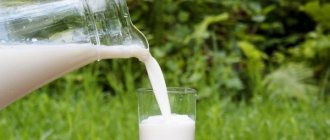What to eat to make milk
Nutrition for a nursing mother is one of the most important components necessary for her health, the well-being of her baby and milk production. But its importance cannot be overestimated. WHO experts are confident that the diet of a nursing mother has little effect on the quality and quantity of milk, the content of microelements and vitamins in it (with the exception of A and D, selenium, iodine and fatty acids, which is also important).
In general, to begin with, it is worth determining whether it is really necessary to stimulate milk production with foods or whether the mother is simply nervous for nothing. To do this, doctors have come up with several methods, for example, the “wet diaper” test and monitoring the baby’s weight gain. If the deficiency is confirmed, comprehensive measures will be required to improve lactation, including the right food.
Check the fat content of mother's milk - this indicator affects its nutritional value. To check, part of the milk is expressed into a glass container and left for 7 hours. During this time it will separate and the fat will rise to the top. If it occupies 4% or more of the total volume, everything is in order, but if it is less, you can slightly adjust your diet.
To make milk fattier, you need to include the following products in your diet:
- walnuts and other nuts;
- halva;
- porridges and soups with cereals;
- broccoli;
- lean meat and fish;
- cheese, cream, sour cream, butter.
At the same time, you should not overeat - this will not enhance the effect of the food, but it can cause allergies, colic or indigestion in the baby. You can eat no more than 2-3 walnuts a day; their abuse often causes allergies.
So, conditionally dairy products for nursing mothers. First of all, include more protein foods in your diet, namely through proteins, and not empty carbohydrates (in the form of sweets and baked goods), and monitor the calorie content of your dishes. Proteins are a kind of building material for the baby’s body, so the mother’s menu must include lean meat, chicken, and fermented milk products (cottage cheese, cottage cheese, fermented baked milk, kefir).
Nuts, especially almonds, are good for improving the quality of milk. To slightly reduce the risk of allergies, you can make nut milk from them. This is done quite simply - 2 tbsp. peeled nuts are infused in a glass of boiled milk for half an hour, and then drunk in three doses during the day.
You can prepare such a drink using water, using a slightly different technology - pour a spoonful of nuts into a glass of water and leave overnight. In the morning they are brought to a boil, then cooled and drunk. The taste is an acquired taste, so you can improve it by adding a little honey.
The list of foods for lactation must include vegetables and fruits. But you also need to be careful with them - after all, many of them are considered strong allergens. With this caveat, you need to include in the menu:
- radish, carrots, onions;
- watermelon, gooseberries, currants, blueberries;
- lettuce, dill, fennel leaves;
- seeds (sunflower, cumin, fennel).
It is better not to mix all these foods, but to eat them one at a time. This, firstly, will help track the baby’s reaction, and secondly, it will help avoid bloating and colic, since some products from the list are completely incompatible with each other.
Honey deserves special mention. Although it is a strong allergen, it has many beneficial properties. Honey is involved in the creation of blood cells, improves digestion, helps avoid constipation, and is also useful for lactation. Of course, you don’t need to eat it in jars, but you can afford a teaspoon a day if neither the mother nor the baby has allergies.
The menu includes fatty fish, buckwheat or oatmeal porridge, bran bread, and dairy products. They help improve digestion, replenish the deficiency of substances necessary for the mother, and enhance lactation.
In the same way, the amount of liquid you drink does not affect the amount of breast milk - neither tea nor other drinks increase lactation, but only facilitate the release of milk. Therefore, it is recommended to drink something warm half an hour before feeding, but what exactly is practically unimportant. At the same time, it is important to prevent the mother from becoming dehydrated, so you still need to drink at a sufficient level - at least 2-2.5 liters per day.
First of all, this is, of course, pure still water. A glass of water in the morning before meals will start the gastrointestinal tract and help avoid constipation. This is an absolutely and completely safe drink, unless, of course, you drink it straight from the tap.
Despite the popular belief that cow's milk enhances lactation, this is not true. It is generally better to temporarily exclude whole milk; it is often poorly accepted by newborns, as it contains a certain type of protein that causes allergies. Starting from 1 month, milk can be drunk baked, but also in small quantities. And if you still really want milk, you can try replacing cow’s milk with goat’s; it is completely safe, although it has a rather specific taste.
You can also use:
- kefir, fermented baked milk;
- chicory (instead of coffee);
- black and green tea (do not increase lactation, but if you drink it half an hour before feeding, it will facilitate the release of milk, like any other warm drink);
- ginger tea;
- herbal infusions and decoctions;
- dried fruit compotes;
- freshly squeezed fruit, vegetable and berry juices (only if there are no allergies).
For the first time, you only need to taste any product or drink lightly - no more than two sips. If there is no negative reaction, you can drink more.
How do you know if your baby has enough milk?
In the first days of a baby’s life, there are usually no problems with feeding. Of course: after all, next to the young mother there is medical staff, answering all questions at any moment!
Nurses will help a woman pump out the breast, teach her how to put her baby to the breast correctly, and doctors will monitor how the mother’s milk comes in and explain how to prolong breastfeeding for a long time.
But upon returning home, the young mother will need to independently learn to guess the baby’s wishes, determine whether he is full, and for what reason he is crying.
You can determine whether your baby is hungry or not by the nature of his stool. If the baby receives enough milk, his stool becomes dark yellow in color, has a faint odor and a slightly watery consistency.
You can tell if your baby is hungry by looking at the stool!
The number of bowel movements in a well-fed child in the first months of life is up to 8 times a day. This is completely normal and confirms that your baby is getting enough breast milk.
If the frequency of stools has changed and the color has changed to brown, the baby needs more food. Just don’t rush to introduce baby formula for complementary feeding: usually, adjusting the mother’s diet leads to an increase in her milk supply.
The second surest indicator of your baby's satiety is the amount of his urine and its color. If the baby’s diaper is full every 3-4 hours and is heavy, and the absorbed discharge is light in color, the baby is most likely not experiencing malnutrition.
This sign is typical for a baby older than five days of age; before this time, the urine may have a dark color - this is normal, do not worry.
You can find out if your baby is getting enough milk by weighing him before and after each feeding. To do this, purchase special scales for newborns (you can rent them or buy them in a store).
Massage to improve lactation
:
- Get on all fours, tilt your head down. Move around the room in this position until you get tired.
- Stand up straight. Spread your arms out to the sides, then cross them in front of you like scissors and spread them out again. Repeat the exercise up to 10 times, raising your arms higher with each swing, finally crossing them above your head.
- Sit cross-legged. Bend your elbows at chest level, placing your palms together and pointing your fingers up. Counting to 3, press your palms tightly together; on the count of 4, relax them without lowering your arms. Repeat 10 times.
Weigh your baby before and after each breastfeeding and note the difference. For 3-5 days, record the milk your child eats. A child aged one week should eat 30-50 ml of milk per feeding. By a month this norm reaches 100 ml.
Of course, each baby is individual: one may eat more milk, another – less. A weakened child will drink less milk than his strong counterpart who was born with a higher weight. Show your schedule to your pediatrician: he will determine whether your baby’s feeding rate needs adjustment and whether you are putting him to the breast correctly.
Whether the baby has enough milk can also be determined by how correctly he grasps the breast when feeding: the baby should wrap his lips around not only the nipple, but also the areola. With his mouth wide open, the child grabs the mammary gland and begins sucking movements, then there is a pause, during which the baby takes a sip of milk and closes his mouth. The longer the pause, the more milk the baby got.
How to improve lactation
In general, nutrition only indirectly affects milk production. The main means that a mother can use to increase lactation is the baby itself and the correct feeding regimen. To increase the amount of breast milk, you can and should use complex measures - one thing will never give an effect, with the possible exception of frequent breastfeeding.
Breastfeed more often
If a mother immediately learns how to properly put her baby to the breast and feeds him on demand - even if he asks to eat every half hour - she most likely will not have problems with lactation. But it can be difficult to achieve ideal conditions, so sometimes milk does not come immediately after childbirth or in the wrong quantity.
In this case, it is important to understand that, first of all, the amount of milk directly depends not on the products, but on the concentration of prolactin, the “milk” hormone, in the mother’s blood. To influence this factor, you need to stimulate the breast and nipple more often - attach the baby or express milk yourself. This is a reliable and effective method, which also does not require any costs.
Colostrum
Every woman in labor should understand that in the first postpartum days, the mammary glands do not produce milk, but colostrum. Sometimes this process occurs already during pregnancy. Therefore, you should not be at all afraid that even before the baby is born, the expectant mother’s bra gets wet and thick discharge appears from the nipples. This is not pus, but most likely the same colostrum that we are talking about now.
Although this option cannot be discounted. That is, there is a possibility of discharge of pus from the nipples during pregnancy. Sometimes the discharge contains an admixture of blood, prolactin, and is dry, cheesy, sticky, and transparent. They should definitely alarm a woman. It is quite possible that this is a bell signaling the onset or progression of the disease.
Therefore, it is very important to distinguish colostrum from other secretions. It has a white color, without an unpleasant sour or musty odor (reminiscent of the light aroma of fresh milk), a uniform consistency (slightly thicker than milk), is released without pain and, of course, is not accompanied by an increase in temperature.
What to do if the discharge from the breast does not look like colostrum at all? What should you do if your colostrum has a slightly pinkish or greenish tint? How to treat if droplets of curdled mass protrude from the nipple?
First of all, a woman who notices this should immediately consult a doctor for advice. You can't do anything yourself. It is all the more harmful in such cases to turn to traditional medicine, since it is mainly designed not for the quick cure of serious diseases, but for maintaining health and preventing diseases.
Important! It is forbidden to apply compresses (alcohol and hot) to the chest without a doctor’s prescription! Such procedures can only accelerate the development of the disease and provoke a worsening of the condition!
Ways to increase milk production
Lack of lactation occurs for the following reasons:
- the individual structure of the female body, in which less breast milk is produced;
- mixed feeding, when formula is added to the newborn’s diet.
Women, due to a primary lack of milk, begin to feed with formula. It makes more sense not to do this. The quality and quantity of lactation is influenced by the hormone oxytocin, which is released in the body during stimulation of the nipples, contractions, and orgasm. The last 2 cases are associated with uterine contractions.
Let us conclude: in most cases, milk production increases due to the frequent application of the baby to the breast. There are other additional ways to increase lactation at home.
Watch a video on how to increase your breast milk supply:
Relaxation from everyday stress
Great responsibility for caring for the baby and household chores rests with the woman. The mother of the child has no time for herself. Due to stress arising from household chores, milk productivity decreases.
To avoid stress for the mother of a newborn after the birth of the baby, distribute household responsibilities between the parents. If the child's father works often, young mothers are advised to sleep according to the infant's schedule, and not torment the body with household chores.
Complete balanced nutrition
The pediatrician recommends including a maximum of healthy foods that increase lactation in the diet of a nursing mother: nuts, oatmeal, cereals, beans. Oatmeal or oatmeal cookies are best eaten in the morning or as a snack. In Asia, green papaya is eaten as a lactogenic product along with soup.
Most mothers of babies under three months old begin the fight against extra pounds too early. This is good if the diet of a nursing mother consists of 1500 kcal or more, taking into account daily energy costs. Vegetables and fruits should not be excluded from the diet. Watch a video about balanced nutrition during breastfeeding with children's doctor Komarovsky:
Drink more water
When a nursing mother drinks more liquid, including juices, teas and compotes, dehydration does not occur. This is important for the timely flow of milk. If this does not happen, the woman will feel bad.
Breast massage and pumping
At the beginning of breastfeeding, when the baby is not yet a month old, a breast pump helps young mothers. So far, little breast milk is produced. Over time, the baby's appetite grows and the need for milk increases.
You can increase lactation through constant hand expression or a breast pump along with breast massage. The latter helps get rid of lumps in the breast if there is more milk than the baby needs. This prevents the development of mastitis and lactostasis.
The breasts are kneaded between feedings. You can try massaging your breasts using a shower. Hot water activates lactation.
Feeding off schedule
Frequent breastfeeding is an easy way to increase lactation. The nipples are constantly stimulated, which leads to increased milk production. It is necessary to monitor the fat content of breast milk. It depends on her whether the child is full or not.
The fattier the milk, the more valuable it is. Fat content differs by color. If breast milk is blue in color, it is low fat. When the cream separates from the milk after an hour, it means it is fat. In the first case, it is better to feed the baby little by little so that he does not completely give up breastfeeding.
Restrictions on the pacifier
Babies love to suck. This calms them down. That's why pacifiers were invented. But, if a woman wants to increase lactation, she will have to temporarily separate the baby from the pacifier. It is recommended that the child be given the breast, even empty, for a couple of days during the daytime nap to stimulate the nipples. Sometimes pacifiers prevent a baby from learning to latch onto the breast correctly.
Consultation with a breastfeeding specialist
If there is a lack of lactation, young mothers turn to lactation consultants. A specialist helps determine why there is not enough milk and how to increase its production.
Eat more oatmeal
Oatmeal is good for nursing women. It increases your milk supply. It's better not to eat porridge every day. It is recommended to eat yogurt, muesli with milk or fruit along with oatmeal. Oatmeal cookies also increase lactation.
Do not use oral contraceptives
Hormonal contraceptives affect each body differently. Before using birth control pills, first consult your doctor.
Lactogonic teas: ranking of the best
Lactation teas help increase lactation. They are drunk exclusively hot to warm everything inside. Let's look at the best lactation teas for nursing mothers:
- BEBIVITA. Costs 185 rubles. Contains calming lemon balm, anti-inflammatory hibiscus and tonic nettle. Mothers note the rich taste and ease of brewing tea. The only drawback is wasteful consumption.
Grandma's basket. Price - within 70-100 rubles. The Russian manufacturer included anise, cumin, fennel, lemon balm and rosehip with nettle in the lactation tea. The instructions indicate that the tea improves mother’s digestion and relieves the baby from colic. This manufacturer also has teas for babies: with chamomile you can drink from 1 month, with rose hips from 4 months.
The appearance of milk in the breasts of a woman in labor
As it turned out, in the first 3-4 days after childbirth, a woman secretes colostrum from her breasts. Mothers feed it to their newborn babies during this period. This feeding is the most optimal, since it is provided by nature itself.
But if it is so important for a woman in labor to know what day she should expect it to appear, then it is worth clarifying that several factors play a role here:
- what kind of births the woman has had;
- the course of this process (natural or via cesarean section);
- whether the pregnancy was full-term or premature.
In primiparous women, the flow of milk usually occurs 3-5 days after the birth of the baby. The night before this event, the chest begins to hurt, enlarges, and becomes hard. Sometimes the milk comes in so much that the breast enlargement is quite significant. It also happens that the nipples become almost flat or even inverted. In such a situation, it may be difficult for a baby to grasp the nipple during feeding.
After the second or more births, such a sharp tide is no longer observed. The process is smoother. In these cases, the first milk after birth arrives earlier.
Premature pregnancy is a test for the body. He urgently needs to rebuild, and this requires additional efforts. Therefore, the wait for milk to appear in such situations takes a little longer - up to a week. Unfortunately, there are often cases when a woman in such situations does not manage to get milk.
A nursing woman can expect mature milk only a couple of weeks after the baby is born. In terms of its composition, it will not remain constantly stable - the child is growing, he needs adequate nutrition. All this is provided by nature, so the composition of milk is constantly changing. And its quantity also changes.
But in the period between the tenth and twentieth weeks of the feeding process, lactation will be established: milk should be produced stably in a certain individual regime. Changing something during this period can be difficult, almost impossible.
Lactation products for nursing mothers. What to eat to make more milk
Nature provides every newborn with the opportunity to feed on mother's breast milk. During pregnancy, the female body prepares for breastfeeding with the help of special hormones that support lactation. It depends on many factors, and first of all - nutrition.
Every nursing woman needs the most high-calorie and protein-rich food in order to replenish the body's losses during this period. And so that the choice does not turn out to be wrong, in the article we offer advice to nursing mothers on the rules for choosing products to create a healthy balanced diet.
Healthy foods for nursing mothers
The postpartum period is characterized by a woman’s increased appetite, since her body’s main function is to produce milk for the newborn. Mother and child are one, and when the lactation period begins, the mother's breasts respond to the baby's cry if it requires breast milk.
It is necessary to highlight the main products for lactation of a nursing mother. These include:
Many mothers are interested in what to eat to produce more milk? The answer to this question is quite simple - you can eat almost anything. Moreover, it is even necessary to increase the diet of a nursing mother, since her body suffers huge losses of vitamins, microelements and fats.
What to do if mom doesn’t have enough milk?
But if the baby is not calm, and from the results obtained we can conclude that he eats less than normal due to insufficient lactation in a nursing woman (after feeding, the breasts are almost empty), care must be taken to increase milk production. How to do it?
The basic rules that a nursing woman must adhere to are quite simple.
- Good rest both at night and during the day.
- Elimination of physical overload from life. Too much housework (as well as excessive exercise and fitness) harms a woman’s health and reduces lactation.
- Positive emotions, reducing stress in the life of a nursing mother.
- Sufficient balanced and regular meals.
- Drinking enough warm drinks.
- Regularly expressing the remaining amount of milk in the breast.
- But the most important rule is to get qualified advice from a doctor.
Only a specialist in this field will be able to determine the cause of the failure in the breastfeeding process and give the necessary recommendations to eliminate it. In some cases, by the way, doctors suggest that nursing women use pharmaceutical products or use proven recipes from our grandmothers to increase lactation.
Delicious and nutritious dishes that are beneficial during lactation
As menu items, you can offer dietary meat broth, without the use of subcutaneous animal fat. In order to cook it, just take a piece of lean beef, pork or chicken and after boiling, drain the first broth, fill it again with clean water, and then you can prepare the soup. This method of cooking is both healthy and safe for any organism - not only for a nursing mother, but also for the whole family.
Milk porridges are a healthy and nutritious food during the feeding period, because porridges are a source of carbohydrates, proteins and fiber. This composition helps digestion, and subsequently cleanses the body. In addition, a breakfast of milk porridge is the simplest and healthiest way to get the right amount of energy for the body.
Hard varieties of cheese allow you to nourish the female body with healthy fats, proteins and carbohydrates. The benefits and taste of the product will help to please mommy in a natural way, and will also replenish the loss of calcium in the body during lactation.
Fermented milk products for lactation of a nursing mother are also necessary to help replenish all calcium losses and nourish the intestinal flora with bifidobacteria. Mother and child are interconnected, so the entry of bifidobacteria into the mother’s body will have a beneficial effect on the baby’s health.
Juices, such as carrot or apple, are a storehouse of vitamins by nature. Apples help intestinal motility and nourish the body with natural hemoglobin.
Lettuce leaves stimulate the flow of milk into the mother's body. If cucumbers can cause fermentation in the intestines, and this can be transmitted to a newborn, then lettuce leaves are absolutely safe in this regard.
Thus, to increase lactation, you should choose everything natural and healthy, tasty and safe, homemade.
Tasty and healthy - let's talk about the benefits of watermelons
Natural resources are available in every season. For example, in summer and autumn you can see fruit and berry crops such as watermelons on the market. Their varieties are diverse, but they bring the same benefits - they saturate with vitamins and help remove toxins from the body.
Almost every woman is interested in whether nursing mothers can drink watermelon? An assessment of the condition of the body, the presence or absence of allergies in the mother and child, and the high quality of the product itself will help answer this question.
Doctors usually recommend conducting research on the suitability of watermelon at home. To do this, take a glass of water and dip a piece of pulp into it. If the water becomes cloudy, then it is a bad product and should not be eaten. If the water turns pink after two hours, then you have chosen a high-quality watermelon.
Nursing mothers should understand that the described berry has a large amount of pulp, in which harmful and dangerous bacteria quickly multiply. If a ripe fruit lies next to a rotten product, then pathogenic microorganisms can enter it, and thanks to this, the best watermelon can turn into a health hazard.
In addition, in the first months of feeding, you should not eat this berry, so as not to cause allergies in the child. The risk of poisoning is quite high, and therefore watermelon is most often not recommended for nursing mothers.
A popular drink among nursing mothers is Hipp tea.
The natural composition of Hipp tea is completely compatible with the body of a nursing mother, as it contains herbs that promote milk production, restoration of health after childbirth and saturation with vitamins.
During lactation, it is very important that nutrients enter the body not only with food, but also with drinks. In addition, the healing properties of herbs such as fennel, nettle, lemon balm and others have been known since ancient times.
The benefits of this drink can be judged by what Hipp tea consists of:
- fennel and galega – increase lactation;
- cumin – has a calming effect;
- anise – has a sedative effect, relieves tension, stimulates the functions of the mammary glands;
- lemon balm - a sedative;
- nettle – strengthens the walls of blood vessels.
Additionally, to improve the taste, maltodextrin and dextrose are added to the drink, which promote the digestibility of proteins in the intestines. All these lactogenic products help the mother maintain the required level of milk production for breastfeeding.
Due to the fact that tea does not contain sugar or starch, it does not cause side effects. But still, before using it, you should consult with your doctor, who will identify incompatibility if there are any allergic reactions or other factors.
Myths about means to improve lactation
1. Lactogenic agents are harmless and can be taken without consulting a doctor.
Any remedy, even if it is tea made from natural herbs, should be taken only after a doctor’s permission, since herbs, like medicines, have side effects and can cause allergies.
2. When taking drugs that improve lactation, milk is protected from burnout.
This is not true. Milk does not disappear for only about 40 days without pumping and feeding, and then there is a decrease in its production, in addition, this condition threatens mastitis.
3. Lactation must be supported with special medications.
It is not true. Almost all mothers are able to do without stimulants. Lactation crises stand apart. By the way, some mothers deny the effectiveness of teas, herbs and most lactogenic agents.
4. Means to improve lactation are not effective.
There is certainly an effect, and it is, as a rule, clinically proven. All herbal medications must be taken in courses, as they begin to act gradually. Hormonal drugs begin to act immediately, but their use is required only in exceptional cases and after consulting a doctor.
How to take tea
Before drinking the drink, you should prepare it in the simplest and most accessible way. To do this, brew 3-4 teaspoons or 1 tea bag with hot water in a 200-250 ml cup. After this you can drink it. The number of cups per day can be up to four. To increase lactation, you should drink tea 20 minutes before feeding.
Drinking the described drink helps improve the condition of a nursing woman’s body and has a beneficial effect on the nervous system, thereby establishing natural processes in the body. In addition, milk contains substances that eliminate colic in the newborn’s intestines.
The calmer the mother, the calmer the baby, so it is necessary to find products that will contribute to this condition. One such product is Hipp tea. One package can last for a week or two, depending on how much of this drink you drink per day.
The most common mistakes when breastfeeding
Many women who sincerely dream of breastfeeding their baby are faced with the problem of insufficient lactation. One of the errors has already been mentioned here. It lies in the fact that mothers, worried, begin to feed the baby in the very first days. It seems to them that 5 grams of colostrum is too little for their baby to be satisfied. In this way they harm themselves.
After all, a child, having tasted the taste of an artificial formula (and it is sweeter than colostrum and human milk), having sucked from a bottle (and this is much easier!), simply refuses to take the breast or sucks, but less actively. Because of this, the mammary glands produce less milk. And gradually its quantity decreases to such an extent that the child has to be completely transferred to artificial feeding.
The second mistake is that many people consider colostrum and milk to be food and therefore necessarily supplement it with water. There is no need to do this. The baby's stomach becomes fuller and he suckles less.
The third mistake stems from Soviet times, when mothers were given a certain time for breastfeeding. It was determined half an hour every 4 hours. Therefore, the baby had to adapt to this regime. And the nursing mother herself was forced to endure overcrowding of the mammary gland in cases where there was sufficient lactation.
This should also include the abolition of night feedings. In those days when nursing mothers were forced to go to work as soon as the baby was two months old, they needed a full night's sleep. Based on this situation, this recommendation was born.
Due to the fact that the breasts do not receive the necessary stimulation and are rarely freed from milk, the lactation process is slowed down. Sometimes this can cause the milk to disappear completely.
These erroneous rules (feeding after 4 hours and denying the baby food at night) for unknown reasons persisted for quite a long time even after the adoption of the law on leave for women to care for the baby. Recently, doctors have been inclined to recommend feeding infants on demand, regardless of the time of day.
How to cook rolled oats
Hercules with milk is an old recipe known to our grandmothers. It's quite simple to prepare:
- One part of water is mixed with 3 parts of milk; it is better to take goat milk, as it is much closer in composition to human milk.
- There should be approximately 1 cup of liquid. For this volume, take 1 tablespoon of rolled oatmeal flakes ground in a coffee grinder.
- All this should be placed in a saucepan and boiled for 20 minutes.
Rolled oats with milk will be beneficial for the gastrointestinal tract because it contains fiber and protein.
Basic useful tips for breastfeeding
The lactation period begins for a woman from the moment her child is born. In the first 2 days, the baby can be fed colostrum, which is formed in the mammary glands before milk appears.
With the onset of lactation, the baby will be completely saturated with mother's milk and will not require additional nutrition. And in order to have enough of it, the nursing mother should create a rational menu and take care of her sleep and rest schedule. A woman’s psychological state directly affects the production of hormones.
Lactation products for a nursing mother should be only the healthiest and most affordable, such as cottage cheese, milk, cheese, meat, some fruits and vegetables. A sufficient amount of liquid will replenish the body with the necessary amount of moisture, restore the nervous system and allow milk to be produced in the required volume.











